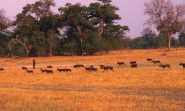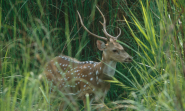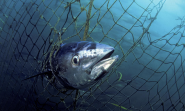-
About
- About Listly
- Community & Support
- Howto
- Chrome Extension
- Bookmarklet
- WordPress Plugin
- Listly Premium
- Privacy
- Terms
- DMCA Copyright
- © 2010-2025 Boomy Labs

 Laurie Fino
Laurie Fino
Listly by Laurie Fino

People usually think of leopards in the savannas of Africa but in the Russian Far East, a rare subspecies has adapted to life in the temperate forests that make up the northern-most part of the species' range. Similar to other leopards, the Amur leopard can run at speeds of up to 37 miles per hour.

European hunters are responsible for the early decline of black rhino populations. It was not uncommon for five or six rhinos to be killed in a day for food or simply for amusement. European settlers that arrived in Africa in the early 20th century to colonize and establish farms and plantations continued this senseless slaughter.

This subspecies of the western gorilla is very similar in appearance to the more numerous western lowland gorilla, but subtle differences can be found in the skull and tooth dimensions. Cross River gorillas live in a region populated by many humans who have encroached upon the gorilla's territory-clearing forests for timber and to create fields for agriculture and livestock.

Hawksbills are named for their narrow, pointed beak. They also have a distinctive pattern of overlapping scales on their shells that form a serrated-look on the edges. These colored and patterned shells make them highly-valuable and commonly sold as "tortoiseshell" in markets. Hawksbills are found mainly throughout the world's tropical oceans, predominantly in coral reefs.

Javan rhinos are found in only one protected area in the world. The biology of the species is poorly understood because techniques for accurately estimating their numbers are not fully developed. They are extremely vulnerable to extinction due to natural catastrophes, diseases, poaching, and potential inbreeding.

Leatherback turtles are named for their shell, which is leather-like rather than hard like other turtles. They are the largest marine turtle species and also one of the most migratory, crossing both the Atlantic and Pacific Oceans. Although their distribution is wide, numbers of leatherback turtles have seriously declined during the last century as a result of intense egg collection and fisheries bycatch.

As their name implies, mountain gorillas live in forests high in the mountains, at elevations of 8,000 to 13,000 feet. They have thicker fur, and more of it, compared to other great apes. The fur helps them to survive in a habitat where temperatures often drop below freezing.

The saola was discovered in May 1992 during a joint survey carried out by the Ministry of Forestry of Vietnam and WWF in north-central Vietnam. The team found a skull with unusual long, straight horns in a hunter's home and knew it was something extraordinary.

Although China outlawed tiger hunting in 1979 and declared the South China tiger's survival a conservation priority in 1995, it is thought that even if a few individuals remain, no existing protected areas or habitat are sufficiently large, healthy or undisturbed enough to sustain viable tiger populations.

Sumatran elephants feed on a variety of plants and deposit seeds wherever they go, contributing to a healthy forest ecosystem. They also share their lush forest habitat with several other endangered species, such as the Sumatran rhino, tiger, and orangutan, and countless other species that all benefit from an elephant population that thrives in a healthy habitat.

Sumatran rhinos are the smallest of the living rhinoceroses and the only Asian rhino with two horns. They are covered with long hair and are more closely related to the extinct woolly rhinos than any of the other rhino species alive today.

Today, the last of Indonesia's tigers-now less than 400-are holding on for survival in the remaining patches of forests on the island of Sumatra. Accelerating deforestation and rampant poaching mean this noble creature could end up like its extinct Javan and Balinese relatives.

In the upper part of Mexico's Gulf of California lives the world's smallest porpoise, the vaquita. Rare and elusive, this little porpoise wasn't discovered until 1958. Today, little is known about them. Vaquitas are most often found close to shore in the Gulf's shallow waters, although they quickly swim away if a boat approaches.

The western lowland gorilla is the most numerous and widespread of all gorilla subspecies. Populations can be found in Cameroon, the Central African Republic, the Democratic Republic of Congo and Equatorial Guinea as well as in large areas in Gabon and the Republic of Congo.

Protect endangered species, including the african wild dog, at World Wildlife Fund. Learn about the ways WWF works to conserve a future where people live in harmony with nature.

Amur tigers were once found throughout the Russian Far East, northern China, and the Korean peninsula. By the 1940s, hunting had driven the Amur tiger to the brink of extinction-with no more than 40 individuals remaining in the wild. The subspecies was saved when Russia became the first country in the world to grant the tiger full protection.

Elephants are an important cultural icon in Asia. According to Indian mythology, the gods (deva) and the demons (asura) churned the oceans in a search for the elixir of life so that they would become immortal. As they did so, nine jewels surfaced, one of which was the elephant.

Habitat Loss Less than a hundred years ago, tigers prowled all across the Indian subcontinent. Exploding human populations, particularly since the 1940s, have resulted in major loss of tiger habitat. Habitats are further fragmented because of agriculture and the clearing of forests for developments like road networks.

To combat the destruction of the black spider monkey's habitat, WWF works to protect the forests they need to survive. We support the creation and management of protected areas and promote responsible forest management, including Forest Stewardship Council (FSC) certification, outside of protected areas.

Once thought to be globally extinct, black-footed ferrets are making a comeback. For the last thirty years, concerted efforts from many state and federal agencies, Indian tribes, conservation organizations and private landowners have given black-footed ferrets a second chance for survival.

Blue Whale - A vulnerable underwater heavyweight. Protect endangered species at World Wildlife Fund. Learn about the various wild animal protection programs we have.

Since 2008, WWF has been tagging Atlantic bluefin tuna in the Mediterranean Sea to learn more about the species. The data collected so far has helped us learn more about their migratory behaviors and enabled us to advise fisheries managers on how best to protect the species.

Bonobos and chimpanzees look very similar and both share 98.7% of their DNA with humans-making the two species our closest living relatives. Bonobos are usually a bit smaller, leaner and darker than chimpanzees. Their society is also different-bonobo groups tend to be more peaceful and are led by females.

Bornean orangutan populations have declined by more than 50% over the past 60 years, and the species' habitat has been reduced by at least 55% over the past 20 years. The Bornean orangutan differs in appearance from the Sumatran orangutan, with a broader face and shorter beard and also slightly darker in color.

Walt Disney himself couldn't have crafted a cuter elephant. The pygmy elephants of Borneo are baby-faced with oversized ears, plump bellies and tails so long they sometimes drag on the ground as they walk. They are also more gentle-natured than their Asian elephant counterparts.
